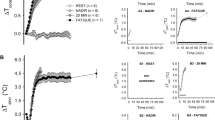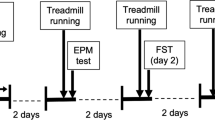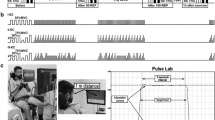Summary
We tested whether the stress of nonreward has neurochemical effects on noradrenergic neurones which resemble those reported for other forms of stress. Rats trained to run in a straight runway for food reward were subjected to either 1 or 10 extinction trials. Half the rats in each group were injected before the start of acquisition with IP 6-hydroxydopamine to deplete peripheral noradrenaline stores. All animals were killed immediately after their final test in the runway, together with untrained controls. Noradenaline depletion had no behavioural or neurochemical effects. The rate of extinction in the 10-trial group, which was indexed by the slope of the linear regression of running time on trial, correlated negatively with both alpha2 and beta-adrenoceptor number (Bmax). There were no differences between groups in cerebral cortical noradrenaline content, or alpha2 or beta-adrenoceptor binding. These results substantially conflict with those predicted from Stone's hypothesis relating beta-adrenoceptor sensitivity to the behavioural response to stress. A further finding was that alpha2, but not beta-adrenoceptor number, negatively correlated with levels of noradrenaline in the tissue, suggesting that noradrenaline is less involved in the regulation of beta than in that of alpha2-adrenoceptors.
Similar content being viewed by others
References
Birch PJ, Anderson SMP, Fillenz M (1986) Mild chronic stress leads to desensitisation of presynaptic autoreceptors and a long-lasting increase in noradrenaline synthesis in rat cortical synaptosomes. Neurochem Int 9: 329–336
Dolphin AC (1982) Noradrenergic modulation of glutamate release in the cerebellum. Brain Res 252: 111–116
Gray JA (1975) Elements of a two-process theory of learning. Academic Press, London
Gray JA (1977) Drug effects on fear and frustration: possible limbic site of action of minor tranquilizers. In: Iversen S, Iversen SD, Snyder SH (eds) Handbook of psychopharmacology, Vol 8. Drugs, neurotransmitters and behaviour. Plenum Press, New York, pp 433–529
Gray JA (1982) The neuropsychology of anxiety. Oxford University Press, New York
Kirk RE (1982) Experimental design for the behavioral sciences, 2nd edn. Brooks Cole, Monterey CA
Kostrzewa RM, Jacobowitz DM (1974) Pharmacological actions of 6-hydroxydopamine. Pharmacol Rev 26: 199–288
Lowry OH, Rosebrough NJ, Farr AL, Randall RJ (1951) Use of the folin phenol reagent in protein determinations. J Biol Chem 193: 265–273
Lucki I, Frazer A (1985) Performance and extinction of lever press behavior following chronic administration of desipramine to rats. Psychopharmocology 85: 253–259
Munson PJ, Rodbard D (1980) Ligand: a versatile computerized approach for characterization of ligand binding systems. Analyt Biochem 107: 220–239
Paykel ES, Myers JK, Dienelt MN, Klerman GL, Lindenthal JJ, Pepper MP (1969) Life events and depression: a controlled study. Arch Gen Psychiat 21: 753–760
Prudo R, Brown GW, Harris T, Dowland J (1981) Psychiatric disorder in a rural and urban population. 2. Sensitivity to loss. Psychol Med 11: 601–616
Raiteri M, Maura G, Versace P (1983) Functional evidence for two stereochemically different alpha2-adrenoceptors regulating central norepinephrine and serotonin release. J Pharmacol Exp Ther 224: 679–683
Redmond DE (1979) New and old evidence for the involvement of a brain norepinephrine system in anxiety. In: Fann WG, Karacon I, Porkorny AD, Williams RL (eds) Phenomenology and treatment of anxiety. Spectrum, New York, pp 153–203
Salmon P, Stanford SC (1988) Peripheral noradrenaline depletion does not impair extinction of food-reinforced running in the rat. J Autonom Nerv Syst 23: 79–81
Salmon P, Stanford SC, Gray JA (1985) The effect of peripheral noradrenaline depletion on responding on a schedule of differential reinforcement of low rates of response (DRL). Psychopharmacology 87: 77–80
Simson PG, Weiss JM, Hoffman LJ, Ambrose MJ (1986) Reversal of behavioral depression by infusion of an alpha-2 adrenergic agonist into the locus coeruleus. Neuropharmacology 25: 385–389
Stanford SC, Fillenz M, Ryan E (1984) The effect of repeated mild stress on cerebral cortical adrenoceptors and noradrenaline synthesis in the rat. Neurosci Lett 45: 163–167
Stone EA (1979) Subsensitivity to norepinephrine as a link between adaptation to stress and antidepressant therepy: an hypothesis. Res Commun Psychol Psychiat Behav 4: 241–255
Stone EA, Platt JE (1982) Brain adrenergic receptors and resistance to stress. Brain Res 237: 405–414
Svensson TH (1987) Peripheral, autonomic regulation of locus coeruleus noradrenergic neurons in brain: putative implications for psychiatry and psychopharmacology. Psychopharmacology 82: 1–7
Ueda H, Goshima Y, Misu Y (1983) Presynaptic alpha and dopamine receptor-mediated inhibitory mechanisms and dopamine nerve terminals in the rat hypothalamus. Neurosci Lett 40: 157–162
Weiss JM, Bailey WH, Goodman PA, Hoffman LJ, Ambrose MJ, Salman S, Charry JM (1982) A model for neurochemical study of depression. In: Spiegelstein MY, Levy A (eds) Behavioral models and the analysis of drug action. Elsevier, Amsterdam, pp 195–223
Weiss JM, Simson PG, Hoffman LJ, Ambrose MJ, Cooper S, Webster A (1986) Infusion of adrenergic receptor agonists and antagonists into the locus coeruleus and ventricular system of the brain. Neuropharmacology 25: 367–384
Willner P, Montgomery T, Bird D (1981) Behavioural changes during withdrawal from desmethylimipramine (DMI). II. Increased resistance to extinction. Psychopharmacology 75: 60–64
Author information
Authors and Affiliations
Rights and permissions
About this article
Cite this article
Stanford, S.C., Salmon, P. Neurochemical correlates of behavioural responses to frustrative nonreward in the rat: implications for the role of central noradrenergic neurones in behavioural adaptation to stress. Exp Brain Res 75, 133–138 (1989). https://doi.org/10.1007/BF00248536
Received:
Accepted:
Issue Date:
DOI: https://doi.org/10.1007/BF00248536




